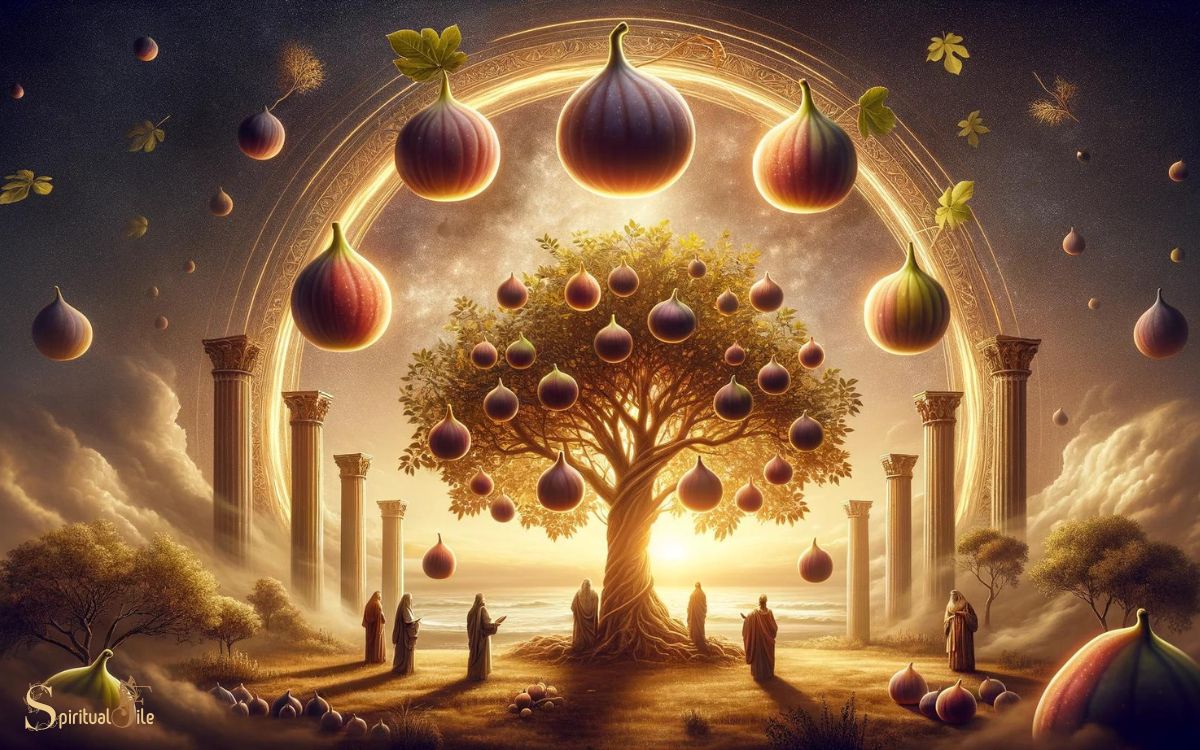What Do Figs Symbolize Spiritually? Fertility!
Figs are rich in spiritual symbolism, often representing fertility, prosperity, knowledge, and enlightenment across various cultures and religions.
They are seen as a conduit for spiritual growth and a symbol of life’s fullness. The fig tree and its fruit have been held in high regard spiritually since ancient times.
They are frequently mentioned in religious texts and mythologies, where they symbolize:
- Fertility and sexuality: Due to their numerous seeds and teardrop shape, figs represent fecundity and can be seen as an emblem of fertility and sensuality.
- Peace and prosperity: A fig tree is often associated with a peaceful and prosperous life, as its shade and fruit provide sustenance and comfort.
- Knowledge and enlightenment: In some traditions, the fig is connected to awareness and the enlightenment that comes with spiritual growth.
For example, in Christianity, the fig tree is mentioned in the story of Adam and Eve, where fig leaves provide the first clothing, symbolizing the awakening to knowledge.
Embodied within the sweet flesh of figs lies a tapestry of spiritual meanings, weaving together themes of life’s richness and the pursuit of deeper understanding.

Key Takeaway
Historical and Cultural Significance

The historical and cultural significance of figs can be traced back to ancient civilizations, where they held symbolic importance in religious rituals and folklore.
In ancient Greece, the fig was associated with Dionysus, the god of wine, fertility, and revelry. It was also believed that the fig tree was the first cultivated plant and was highly esteemed in Greek culture.
In ancient Egypt, the fig tree was considered a sacred tree and a symbol of abundance and prosperity.
Figs were also depicted in ancient Mesopotamian art and were mentioned in the Bible as a symbol of peace and prosperity.
The fig’s prominence in various ancient cultures demonstrates its enduring symbolic significance and its deep-rooted connection to spirituality and cultural traditions.
Biblical Symbolism

In biblical symbolism, figs are associated with various spiritual meanings and are often used to represent abundance, peace, and prosperity.
The fig tree is mentioned numerous times in the Bible, and it holds significant symbolism in both the Old and New Testaments.
In the Old Testament, figs are seen as a symbol of peace and prosperity. They are referenced as a sign of abundance in the promised land.
In the New Testament, the fig tree is used metaphorically to represent the nation of Israel and is associated with spiritual awakening and the recognition of the signs of the times.
Figs are also used as a metaphor for the spiritual abundance that comes from a life of faith. They symbolize the spiritual fruit that believers are expected to bear in their lives.
Fertility and Abundance

Figs symbolize spiritual fertility and abundance, embodying the concept of fruitfulness and prosperity in various religious and cultural contexts.
This symbolism is deeply rooted in the fig’s ability to produce an abundance of sweet, succulent fruits, which has led to its association with fertility, abundance, and prosperity across different belief systems.
The spiritual significance of figs in relation to fertility and abundance includes:
- Figs as a representation of the earth’s abundance and fertility.
- The fig tree as a symbol of prosperity and wealth.
- The fig’s role in fertility rituals and practices.
- Figs as a metaphor for spiritual and material abundance.
- The connection between figs, fertility, and the cycle of life.
Understanding the symbolism of figs in relation to fertility and abundance provides insight into their broader spiritual significance.
Next, let’s explore the symbolism of figs in different religions.
Fig Symbolism in Different Religions

The symbolism of figs is present in various religious traditions, each offering unique perspectives on the spiritual significance of this fruit.
- In Christianity, figs are mentioned in the Bible, often associated with abundance and prosperity.
- Islam holds the fig in high regard, with references in the Quran and Hadith highlighting its importance.
- Hinduism also incorporates figs into its beliefs, where they are seen as sacred and linked to spirituality.
Fig Symbolism in Christianity
Christianity associates figs with various spiritual meanings, reflecting the diverse symbolism found in different religions.
In Christianity, figs hold significant symbolism, representing various aspects of faith and spirituality:
- Abundance and Prosperity: Figs are seen as a sign of abundance and prosperity in the Christian faith, symbolizing God’s blessings and the fruitful nature of a life lived in accordance with His will.
- Spiritual Growth: The growth process of a fig tree, from a tiny seed to a mature tree bearing fruit, is often used to symbolize the spiritual growth and maturity of believers.
- Repentance and Restoration: The story of Jesus cursing the fig tree serves as a lesson on the importance of genuine faith and the consequences of spiritual barrenness.
- Nourishment and Healing: Figs are associated with nourishment and healing in the Bible, representing the spiritual sustenance and restoration provided by God.
- Seasons and Times: The ripening of figs at a specific time of the year is used to symbolize the importance of recognizing and seizing the opportunities presented by God in different seasons of life.
Fig Significance in Islam
In the context of spiritual symbolism, figs hold significance in Islam, representing various aspects of faith and spirituality.
In Islamic tradition, the fig tree is considered sacred, mentioned in the Quran as a symbol of peace and abundance.
Figs are also believed to have been among the fruits of the Paradise, making them a symbol of blessings and sustenance.
The fig’s significance in Islam extends to its medicinal properties, as it is mentioned that Prophet Muhammad extolled the healing virtues of figs.
Moreover, the fig tree’s resilient nature and ability to thrive in arid conditions are often seen as a metaphor for the steadfastness and perseverance required in one’s faith.
Thus, in Islam, figs symbolize not only physical nourishment but also spiritual enrichment and resilience.
Figs in Hinduism Beliefs
Symbolizing spiritual abundance, figs hold significance in Hinduism beliefs, reflecting similar themes of nourishment and resilience found in Islam’s interpretation of their symbolism.
In Hinduism, the fig tree is revered as a symbol of enlightenment and knowledge, with the banyan tree, a species of fig, being particularly sacred.
The tree’s extensive root system signifies stability and the interconnectedness of all living beings. Additionally, in Hindu mythology, the fig tree is associated with various gods and goddesses, further emphasizing its spiritual importance.
Figs are also used in religious rituals and offerings, representing sustenance and the cycle of life. Furthermore, the fig’s ability to thrive in diverse environments is seen as a metaphor for adaptability and strength in the face of adversity.
- Fig tree as a symbol of enlightenment and knowledge
- Banyan tree as sacred and symbolizing interconnectedness
- Association with various gods and goddesses in Hindu mythology
- Use in religious rituals and offerings
- Metaphor for adaptability and strength
Spiritual Awakening and Enlightenment

The concept of spiritual awakening and enlightenment is often associated with the symbolism of figs. Figs are seen as a source of spiritual nourishment and are deeply rooted in symbolic significance.
Understanding the spiritual connotations of figs can offer valuable insights into the journey of enlightenment and the awakening of the soul.
Figs as Spiritual Nourishment
As a symbol of spiritual nourishment, figs represent a source of enlightenment and awakening for many spiritual traditions.
Figs are seen as a conduit for spiritual nourishment, providing sustenance for the soul and aiding in the journey towards enlightenment.
In various spiritual contexts, the fig is revered for its ability to nourish the body and mind, leading to a deeper understanding of the self and the world.
The spiritual significance of figs as nourishment is rooted in their ability to facilitate inner growth and transformation.
Figs are believed to offer spiritual nourishment in the following ways:
- Fostering inner peace and tranquility
- Facilitating self-reflection and introspection
- Supporting the pursuit of spiritual knowledge and wisdom
- Promoting a deeper connection to the divine
- Nurturing the soul on the path to enlightenment
This spiritual nourishment provided by figs is integral to the symbolic significance of this fruit.
Transitioning into the subsequent section about ‘symbolic significance of figs’, the spiritual nourishment they offer is deeply intertwined with their symbolic importance.
Symbolic Significance of Figs
Representing a gateway to spiritual awakening and enlightenment, figs hold a revered symbolic significance across various spiritual traditions.
- In Christianity, the fig tree is mentioned in the Bible as a symbol of peace and prosperity.
- In Hinduism, the fig tree is associated with the world tree, representing the interconnectedness of all living beings.
- Additionally, in Buddhism, the fig tree is linked to the concept of enlightenment, as it is believed that Buddha attained enlightenment while meditating under a fig tree.
The symbolic significance of figs in spiritual awakening and enlightenment is summarized in the table below:
| Tradition | Symbolic Significance |
|---|---|
| Christianity | Peace and Prosperity |
| Hinduism | World Tree |
| Buddhism | Enlightenment |
These interpretations of figs as a representation of spiritual enlightenment serve as a reminder of the potential for inner growth and realization within each individual.
Can the Symbolism of Pyramids be Connected to the Symbolism of Figs in Spiritual Beliefs?
The spiritual symbolism of pyramids has been connected to the symbolism of figs in various spiritual beliefs throughout history. Both are often seen as representing abundance, fertility, and eternal life. In some cultures, the fig tree is even considered a symbol of enlightenment, mirroring the spiritual significance of pyramids.
Fig Symbolism in Art and Literature

Symbolizing abundance and fertility, figs have been a recurring motif in art and literature, signifying prosperity and the cycle of life.
In art and literature, figs often represent:
- Abundance: Figs are depicted in paintings and mentioned in poems to symbolize the abundance of nature and the earth’s bountiful harvest.
- Fertility: In various cultures, figs are associated with fertility and the nurturing of new life, often portrayed in sculptures and used as metaphors in novels and plays.
- Sensuality: The luscious and succulent nature of figs is frequently utilized in art and literature to convey themes of sensuality and indulgence.
- Cycle of Life: Figs, with their seasonal ripening and regenerative qualities, are employed as symbols of the cyclical nature of life and the passage of time.
- Nourishment: In still-life paintings and narratives, figs are often used to depict the nourishing and sustaining aspects of food and sustenance.
Conclusion
The spiritual symbolism of figs is deeply rooted in history, culture, and religion. Figs represent fertility, abundance, and spiritual awakening across various belief systems. Their significance in art and literature further highlights their symbolic importance.
The fig’s rich spiritual symbolism transcends time and continues to inspire and enlighten individuals on a profound level, making it an enduring and powerful symbol in the spiritual realm.






